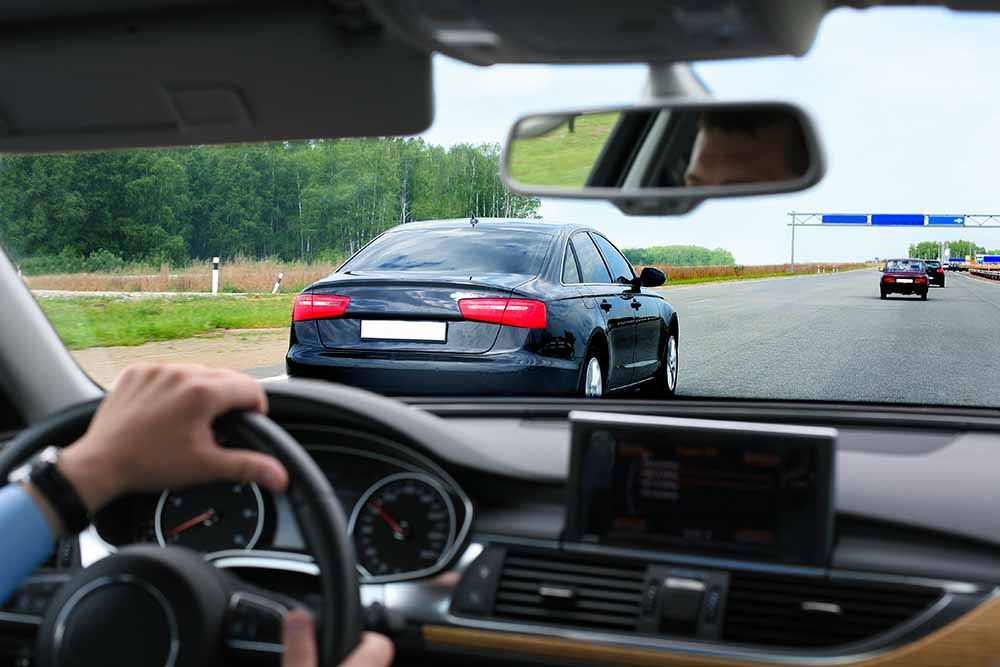
Cars may be getting smarter, but until the day self-driving vehicles take over (and it’s going to be a while), your behind-the-wheel technique could probably use some improvement. Whether you’re a recent licensee or a veteran driver, there’s a good chance you’re guilty of a few of the faux pas below. Fortunately, all of these things are fairly easy to correct, and making even small changes to your driving habits can have a big impact on your safety (and the safety of those around you) on the road.
Tailgating Road rage Looking at your phone Mirror adjustment Turn signals Speeding
Tailgating
Even the best drivers are guilty of tailgating – the practice of driving too close to the vehicle in front of you – on occasion. While you may have learned about safe following distances in terms of vehicle lengths or metres, most experts now define tailgating as leaving less than a three-second gap between you and the vehicle in front of you at city speeds, and less than four to six seconds on the highway. To ensure your distance is safe, observe an object as it passes the car ahead of you (an exit sign, for example) and count the seconds until it reaches you. When in doubt, just slow down.
Road rage
Whether it’s interminable traffic, bad weather, or just other drivers being unsafe or inconsiderate on the road, there are plenty of things to annoy and frustrate on your commute. Even the most level-headed driver can be pushed over the edge, but whatever the case, there’s absolutely no good reason to resort to road rage. If you feel yourself starting to boil over, pull over when it’s safe and take a few deep breaths. This will calm you down while putting some more distance between you and the other driver, allowing you both to get safely on with your journeys.
Looking at your phone
Mobile phones have been around long enough that the dangers they pose behind the wheel are well-documented. Our phones, however - which also double as GPS navigation systems and audio players - are now a more vital part of our lives than ever, and they can be extremely difficult to ignore. Nonetheless, the more you’re looking at your phone behind the wheel, the less you’re looking at the road. Instead, try mounting your phone at eye level and turning off notifications before you drive. In fact, some phones now have driving modes designed specifically to reduce distraction behind the wheel, making it that much easier.
Mirror adjustment
Many vehicles now come with blind spot monitoring technology, which has prevented untold numbers of blind spot-related accidents. If your vehicle doesn’t have these sensors (or if you just want to be extra safe), making sure your side mirrors are correctly positioned is one of the easiest things you can do to improve your safety on the road. While most people adjust their mirrors so that the sides of their own vehicles are visible, you will increase visibility (and reduce your blind spot) by positioning them a little farther outward. It might be helpful to think about it this way: your car is always in the same place in relation to the driver, so why do you need to see it in your mirror? Instead, by angling your side mirrors slightly outward (just enough that your car disappears), you’ll be able to see even more of the road and the other vehicles coming up alongside you.
Turn signals
Of all of the good habits you can cultivate as a driver, this is an important one. Turn signals are one of the most important things you can do to keep yourself and other drivers safe on the road, and there’s no replacement for using them whether you’re changing lanes, making a turn on red, or simply navigating a busy parking lot.
Speeding
What’s the rush? Unfortunately, our busy lives can make us feel like we’re always in a hurry to get somewhere, and this leads to a lot of unsafe driving. It’s easy to forget this from the inside of your vehicle, but the faster you’re going, the longer it takes you to stop (exponentially longer at highway speeds, in fact). Speeding can be a very difficult habit to break, but listening to downtempo music and keeping to the right on the highway can both help. If nothing else, it might also help to remember that your vehicle runs most efficiently at slower speeds, which makes speeding not just dangerous, but expensive, too.
Jeremy Freed is a freelance writer and editor based in Toronto. His writing about fashion, travel, food and design appears in Sharp, Harry and re:Porter magazines, among many others.